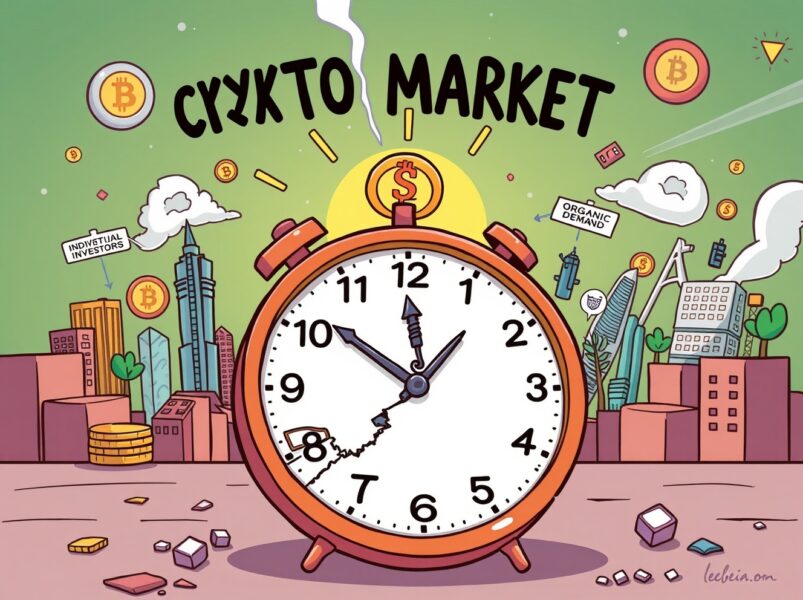Unveiling the End: Why Crypto Market Cycles Are Forever Changed
0
0

BitcoinWorld
Unveiling the End: Why Crypto Market Cycles Are Forever Changed
The cryptocurrency world is buzzing with a groundbreaking declaration from Kim Seo-joon, CEO of South Korean blockchain investment firm Hashed. He has boldly stated that the traditional four-year crypto market cycles, long a defining feature of the industry, are officially over. This isn’t just a casual observation; it’s a profound shift in understanding how the crypto market operates and evolves.
Are the Old Crypto Market Cycles Truly Gone?
For years, many investors and analysts meticulously tracked the predictable rhythm of crypto market cycles. These cycles were largely seen as a mechanical consequence of the Bitcoin halving event. Every four years, the reward for mining new Bitcoin is cut in half, reducing the supply. In a nascent market with limited real demand, this supply shock often triggered a bull run.
Kim Seo-joon argues that this era has passed. He suggests that the halving now holds little sway over the market’s direction. The initial cycles were a simple supply-and-demand dynamic in a relatively small pond. Today, the pond is a vast ocean, and its currents are far more complex.
What’s Driving the New Crypto Market Dynamics?
So, if the halving isn’t the primary driver, what is? Kim Seo-joon asserts that the crypto market is now propelled by robust, organic demand. This demand stems from a variety of powerful sources:
- Retail and Institutional Inflows: A growing number of individual and large-scale institutional investors are entering the space.
- Exchange-Traded Funds (ETFs): The approval and success of spot Bitcoin ETFs, for example, have opened traditional investment avenues to crypto.
- Tokenization: The increasing trend of representing real-world assets on blockchain networks is creating new utility and demand.
- Deeper Financial Integration: Crypto is becoming more interwoven with traditional finance, bringing greater liquidity and legitimacy.
This shift signifies a maturation of the market, moving beyond speculative interest to genuine utility and adoption. It means that the fundamental value proposition of blockchain technology is now attracting significant capital.
Understanding Current Market Shifts Beyond Traditional Crypto Market Cycles
Many might look at recent market downturns and assume a familiar cycle reset. However, Kim Seo-joon offers a different perspective. He views the current volatility not as the start of a new bear market cycle, but as a temporary reallocation of capital.
Amid global economic uncertainty, investors often seek perceived safe havens like gold or shift towards established tech stocks. This doesn’t indicate a fundamental weakness in crypto itself. Rather, it highlights a temporary defensive posture by investors navigating broader economic headwinds.
Crucially, Kim emphasizes that behind the market noise, the core fundamentals of crypto continue to strengthen. Infrastructure is improving, liquidity is deepening, and participation across various blockchain ecosystems is expanding. These are strong indicators of long-term health, even during periods of price fluctuation.
The Future is Tokenized: Navigating the Evolving Crypto Market Landscape
Looking ahead, Kim Seo-joon has a bold vision: “everything ownable will be tokenized.” This implies a future where digital ownership on blockchain becomes the norm for assets ranging from real estate to intellectual property. He sees crypto evolving into the “lifeblood of capitalism,” a fundamental layer for global commerce and finance.
For investors seeking to thrive in this new paradigm, Kim offers actionable advice: stop focusing solely on price charts and traditional cycle indicators. Instead, he recommends tracking on-chain revenue and real cash flows within the crypto ecosystem. These metrics provide a clearer picture of where genuine value is being created and where the “next cycle” of growth is already quietly compounding.
The end of the mechanical four-year crypto market cycles marks a pivotal moment. It signifies a transition from a speculative, supply-shock-driven market to one powered by organic demand, real-world utility, and deep financial integration. This new era demands a more sophisticated understanding and a forward-looking investment approach, focusing on fundamentals rather than historical patterns.
To learn more about the latest crypto market trends, explore our article on key developments shaping Bitcoin institutional adoption.
Frequently Asked Questions About Crypto Market Cycles
Here are some common questions regarding the evolving nature of cryptocurrency markets:
- Q: What did the traditional four-year crypto cycle entail?
A: The traditional cycle was largely driven by the Bitcoin halving event, which reduces the supply of new Bitcoin every four years. In a less mature market, this supply shock often led to significant price increases, creating a predictable boom-and-bust pattern. - Q: Why does Hashed CEO Kim Seo-joon believe these cycles are over?
A: Kim argues that the market has matured significantly. It’s no longer just about supply shocks but is now driven by organic demand from retail and institutional investors, the rise of ETFs, widespread tokenization, and deeper integration with traditional finance. - Q: What are the new drivers of demand in the crypto market?
A: Key drivers include increasing participation from individual and institutional investors, the emergence of crypto-based ETFs, the tokenization of real-world assets, and the growing interconnectedness between blockchain and conventional financial systems. - Q: How should investors adapt to this new market paradigm?
A: Kim Seo-joon advises investors to shift their focus from historical price cycles to fundamental metrics. This includes tracking on-chain revenue and real cash flows within various crypto projects to identify genuine value creation and sustainable growth. - Q: Does the end of the four-year cycle mean less volatility for crypto?
A: Not necessarily. While the mechanical, halving-driven cycles may be diminishing, the crypto market can still experience volatility due to broader economic factors, regulatory changes, and project-specific developments. However, the underlying drivers of growth are becoming more robust and demand-driven.
The crypto landscape is evolving rapidly, demanding new perspectives and strategies. If you found this insight into the changing crypto market cycles valuable, share this article with your network! Help us spread awareness about the exciting shifts happening in the world of digital assets.
This post Unveiling the End: Why Crypto Market Cycles Are Forever Changed first appeared on BitcoinWorld.
0
0
 Manage all your crypto, NFT and DeFi from one place
Manage all your crypto, NFT and DeFi from one placeSecurely connect the portfolio you’re using to start.




